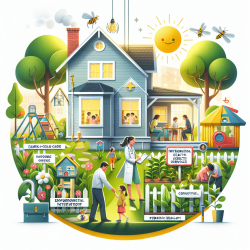Introduction
In the realm of child care, ensuring a safe and healthy environment is paramount. A recent study published in the International Journal of Environmental Research and Public Health sheds light on the efficacy of Integrated Pest Management (IPM) in family child care homes (FCCHs). This blog will explore the study's findings and discuss how practitioners can enhance their skills by implementing these strategies.
Understanding Integrated Pest Management
Integrated Pest Management is a holistic approach to pest control that minimizes the use of harmful pesticides, focusing instead on prevention, monitoring, and control. The study involved a six-month nurse-led intervention that significantly increased IPM knowledge and practices among FCCH directors, reducing pest prevalence by 90%.
Key Findings
- Increased Knowledge: Post-intervention, all participating directors were aware of IPM, a significant increase from only 5% pre-intervention.
- Policy Changes: There was a notable rise in the number of directors implementing written policies on pesticide use, from 10% to 90%.
- Pest Reduction: The intervention led to a dramatic decrease in pest sightings, showcasing the effectiveness of IPM practices.
Implementing IPM in Your Practice
For practitioners looking to adopt IPM strategies, the study provides a comprehensive toolkit available in both English and Spanish. This toolkit includes educational materials, a checklist for assessing IPM practices, and practical tools for immediate implementation.
Here are some steps to get started:
- Educate Yourself: Familiarize yourself with the IPM principles and toolkit materials.
- Assess Your Environment: Use the IPM checklist to identify areas of improvement in your child care setting.
- Develop a Plan: Create an action plan to address identified gaps and enhance pest management practices.
- Engage in Continuous Learning: Attend workshops and seek consultation from trained Child Care Health Consultants (CCHCs).
Encouraging Further Research
While this study highlights the positive impacts of IPM in FCCHs, there is a need for continued research to explore its long-term effects and adaptability across different settings. Practitioners are encouraged to engage with ongoing studies and contribute to the growing body of evidence supporting IPM.
Conclusion
Implementing IPM in family child care homes not only reduces children's exposure to harmful chemicals but also fosters a healthier environment for their growth and development. By adopting these practices, child care providers can play a crucial role in safeguarding children's health.
To read the original research paper, please follow this link: An Integrated Pest Management Intervention Improves Knowledge, Pest Control, and Practices in Family Child Care Homes.










